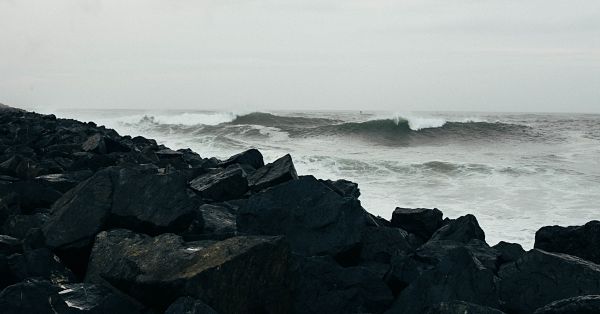This is a sermon I recently preached on Mark 4:35-41, the account of Jesus’s calming of the storm on the Sea of Galilee. It is a short sermon, only about 12 minutes in length. In fact, this is the shortest sermon I’ve ever preached! Of course, I grew up Southern Baptist and 45 minute to hour-long sermons were par for the course. And since it is a sermon, you will probably notice several oral/aural cues throughout that make sense in light of a spoken context.

“Who Then is This?”
On that day, when evening had come, he said to them, “Let us go across to the other side.” 36 And leaving the crowd behind, they took him with them in the boat, just as he was. Other boats were with him. 37 A great windstorm arose, and the waves beat into the boat, so that the boat was already being swamped. 38 But he was in the stern, asleep on the cushion; and they woke him up and said to him, “Teacher, do you not care that we are perishing?” 39 He woke up and rebuked the wind, and said to the sea, “Peace! Be still!” Then the wind ceased, and there was a dead calm. 40 He said to them, “Why are you afraid? Have you still no faith?” 41 And they were filled with great awe and said to one another, “Who then is this, that even the wind and the sea obey him?” (Mark 4:35-41, NRSV)
The Word of God for the People of God.
Fear is a powerful emotion. We’ve all dealt with it. Fear of loss. Fear of the unknown. Fear of pain. Fear of death. Fear of a hostile world. Fear can either motivate us to act or it can paralyze us. And fear—of two very different sorts—is present in our text today.
Let me provide some context to this passage. Jesus has just finished a long day of teaching by the Sea of Galilee. He has been teaching about the Kingdom of God in parables, illustrative stories woven through with imagery from everyday Jewish farm life.[1] These parables speak of how the Kingdom of God comes like a farmer sowing seed, or like a mustard seed, planted small, but over time growing into a large plant that offers shade even to the birds of the air.
But, after a long day of such teaching, Jesus had grown tired. Who among us wouldn’t have? And so, after evening had come, Jesus and his disciples begin to cross to the other side of the Sea of Galilee. But the calm after a long day doesn’t last. Soon, a great and violent windstorm arose, the type of which the Sea of Galilee was well known for.[2] The fishing boats used by Galilean fishermen at that time, had low sides (so that the men could cast and draw in their fishing nets), and would have been easily battered by the wind and waves. Indeed, Mark tells us that boat was quickly beginning to be swamped by the waves of the storm.
The disciples were confronted by fear, but the not the ordinary fear of everyday life. This would have been sheer terror. It is the kind of fear that happens when you are confronted with something that is far larger, far stronger than you have the power to control. The kind of fear that the disciples were experiencing, was that of grandeur turned to terror. The terror of a chaotic world indifferent to their lives. We have all experienced this at some point, even if only as children when we first heard a thunderstorm and realized that there were forces in this world that were far bigger than us, and indifferent to us.
This then is what the disciples were confronted with, the terror and chaos of a great storm. You can hear Mark echoing the chaotic waters of primordial creation in Genesis 1, when the world was dark, wild, and waste (Gen 1:2). You can hear the terror in the Psalmist’s voice in Psalm 107 at great, stormy waves that, “mounted up to heaven,” and that “went down to the depths,” causing the courage of mere mortals to be, “melted away in their calamity” (Ps 107:26).
The terror of an awful storm. And yet Jesus is fast asleep on a cushion in the stern of the boat. Not only is Jesus unafraid of the chaos raging around him and his disciples; he is sleeping! In the face of certain death, Jesus sleeps soundly.
This of course is not at all amusing to the disciples. They rouse him from sleep and ask him what any one of us would have asked: “Do you not care that we are perishing?” It is a reasonable question. And Jesus provides an answer to them, but not in the way you’d expect. Rather than assuring them that everything will be alright, Jesus instead turns toward the wind and the waves, toward the darkness and chaos that threatens to engulf them all.
Jesus rebukes the wind. Now this alone is interesting. Jesus speaks a word of rebuke to the wind. What is interesting about Mark’s use of the verb “rebuke” here, is that it is the same kind of verb that is often used by Jesus when he casts out demons and other dark forces. In the minds of ancient Jews, the sea—the dark, watery abyss—was often thought to be wear demons and other evil forces dwelt. Jesus thus speaks in a manner very similar to how he casts out demonic forces from people.
But there is something more interesting still. Jesus says specifically to the storm: “Peace! Be still!” Just as with the act of “rebuking” the wind, Jesus commands the storm to be silent in a manner akin to that of his driving out of demonic forces. The command “be still” is used earlier in Mark’s gospel to silence a demon before throwing it out a man (1:25).[3]
And yet here, Jesus is not simply silencing dark powers, but the very forces of nature themselves. Holy men could drive out the demonic; but no mere mortal could silence the very wind and sea. That power—that terrible and wonderful power—is something only the Creator God Himself has.[4]
A great calm then comes over the sea. Order is established. The awful terror of the storm is driven away. The wondrous order of creation is restored.
Jesus turns to his disciples and speaks to them for the first time since he’d fallen asleep. He asks them, “Why are you afraid? Have you still no faith?” “And they were filled with great awe”. Mark’s Greek literally says here that they, “feared a great fear.” The terror of the storm has been done away with, but a fear of a very different sort has taken its place. This fear, this reverent awe, is what a man named Rudolf Otto famously called the mysterium tremendum, the Grand Mystery that is simultaneously fearful and fascinating. And it leads the disciples to ask, ‘Who then is this, that even the wind and the sea obey him?’”
Even after all the disciples had seen Jesus do up to this point, even after all the parables he had taught, even after all the innocent people he had freed from demonic oppression, the disciples still did not know Who stood in their midst. Indeed, they are so amazed at what they have just witnessed that all they can do is ask “Who then is this?”
Who indeed is this Man? He who commands the very wind and sea to be silent. Who is this, that He inspires a reverent fear—a glorious awe—greater than that of the might of the terrible storm upon the sea? The disciples are better able to handle the prospect of their own deaths, than the reality of God’s presence, standing in the flesh among them.[5]
We may think we escape Jesus’s probing question to the disciples, “Why are you afraid? Have you still no faith?” And yet that question is one that this Man—this Man who even the wind and the waves obey—puts before us still.
Granted, we may never face imminent death in a seaborne windstorm, but the fallen world we live in thrusts terrors and trials before us every day. We are confronted daily with the dark terrors of a creation that is riven through with evil. And yet, like the disciples on the Sea of Galilee, we are upheld by One who rebukes the wind and says to the waves, “Peace! Be still!”
And so we, as Christians, must answer the question posed by the disciples: “Who then is this that even the wind and the sea obey him?” Jesus stands before us and fills us with reverent awe, with what the Old Testament writers call the “Fear of the LORD”. But this fear, this terrible and beautiful awe, is not at all like that terror brought on by the chaotic storms of this world.
No, this is the shocking and wondrous awe—the fearful and fascinating Mystery—of the Creator God Himself, dwelling in our midst, keeping us afloat in the midst of life’s storms and asking us all, “Why are you afraid?” Though we might be filled with awe at the terrible wonder of Christ, it is this Wonder that is the beginning of God’s wisdom.[6] And so we, like Mark’s first hearers, must answer the question for ourselves, each and every day, with every part of our lives. For, how we as Christians, respond to this question, informs how we will respond to all others. “Who then is this, that even the wind and the sea obey him?”
[1] James R. Edwards, The Gospel according to Mark, PNTC (Grand Rapids: Eerdmans, 2002), 146.
[2] R.T. France, The Gospel of Mark: A Commentary on the Greek Text, NIGTC (Grand Rapids: Eerdmans, 2002), 223.
[3] John R. Donahue and Daniel J. Harrington, The Gospel of Mark, SP 2 (Collegeville, MN: Liturgical Press, 2002), 158-59.
[4] Edwards, Mark, 150-51.
[5] Ibid, 152.
[6] Donahue and Harrington, Mark, 161.















